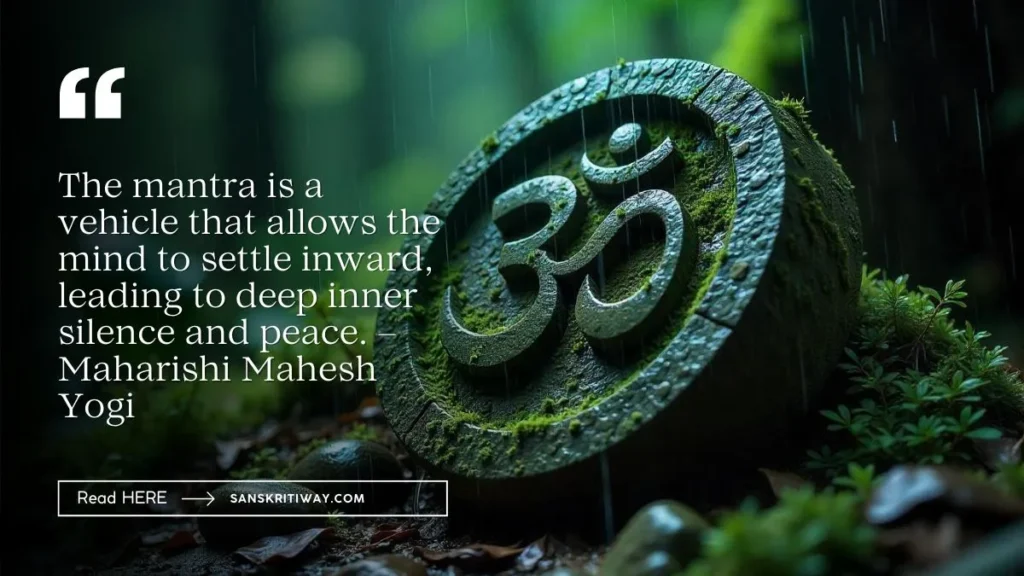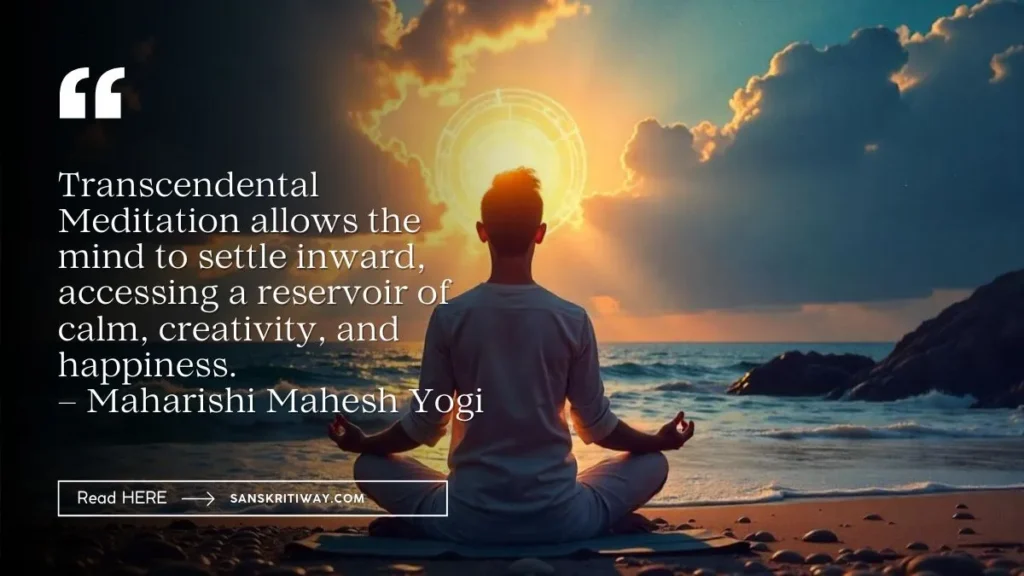Transcendental Meditation (TM) is practiced through silent repetition of a phrase that enables one to achieve a level of conscio™. While other methods require a focus on breath or concentration, TM describes the effortless mantra repetition of a chant as the primary practice. Ancient Vedic cultures, along with its associated health benefits and ease of practice, have popularized this technique.
The unique feature TM encourages is the inner solitude that the mind pursues. “Pure consciousness” is the term given to this serene, yet highly conscious, state that practitioners experience.
How to Do Transcendental Meditation
Executing TM is easy but requires a deep commitment from the practitioner to fully appreciate its advantages. Here is the step-by-step guide to TM:
- Pick a Place with Quiet Surroundings: One must select an area where there is little to no chance of feeling disturbed.
- Remain Sitting: One must sit relaxed with the eyes shut; no active posture is required.
- Silently Repeat a Mantra: A mantra can be chanted out loud or said internally. You can chant phrases, but this one uses elaborate sounds. The repetition should be effortless, without focus or intention.
- Let Thoughts Flow: Each new thought that crosses one’s mind should be allowed to come and go as it pleases. We don’t need to enforce any restrictions.
- Practice Twice Daily for 20 Minutes: The mindful form of meditation is typically held in the morning and evening.
- End Gently: Once the session is over, a few moments should be set aside in order to smooth the transition back to one’s responsibilities.
Effortlessness is one of the most essential concepts of TM. With the majority of meditations, one is required to take considerable time or focus on deep thinking. TM, on the other hand, lets the mind take its time, stroll, and dip into a slumber.
Transcendental Meditation Mantras
Mantras impact the practice of transcendental meditation greatly. Unlike an affirmation or prayer, transcendental meditation stems from mantras. Its sounds are based on their combined vibration equilibria, not meaning. A teacher normally gives TM mantras, which originate from Sanskrit and follow a set structure.
A mantra is a sound larger than the concentration of thoughts, and its aim is to inhibit the stimulus that provokes one’s thinking processes. The sound would pass through the practitioners. That helps the practitioner remove their focus from worrying and instead be more self-aware and relaxed.
People wishing to try TM on their own can start with basic sounds like “Om” or “So Hum” if they are hoping to attain deeper meditative states, while official TM programs provide individualized mantras that are more specific.

Benefits of Transcendental Meditation
There are many who practice TM due to its claimed psychological, physiological, or cognitive advantages. This includes research into the effects of meditation on the clarity of thinking, overall wellness, and, most importantly, stress management.
Mental Health Benefits
Stress or anxiety is extraordinarily common in today’s fast-paced society, and one of the clearest advantages to TM is its ability to relieve tension and anxiety. TM practitioners are said to benefit from lower levels of cortisol—the stress hormone. Regular practice of TM not only strengthens emotional stability but also improves concentration, memory, and imagination. The feelings of greater balance and more calmness TM provides let individuals manage their lives more easily.
Some of those with sleep-enabled disorders are able to take TM, while people suffering from insomnia may find greater calmness during the day, improved sleep, and the relief of feeling more relaxed.
Benefits for physical health
Researchers have examined TM’s influence on physical health in addition to mental well-being. There are some studies that suggest TM is helpful in reducing blood pressure and the risk of heart disease. Furthermore, TM may help treat chronic pain conditions, tension headaches, and other ailments by stimulating the body’s relaxation response.
Moreover, by promoting a state of deep rest, TM also encourages overall immune response and energy levels, thus helping the entire nervous system.
Emotional and Spiritual Development
Aside from mental and physical benefits, TM can actively help in personal development by fostering self-awareness and emotional stability. Numerous practitioners report improvements in achieving profound inner calm, a decrease in emotional reactivity, and an increase in mindful practice throughout their routines.
Many practitioners find that TM increases the sense of connection that one has with themselves and their environment. Although TM is not religious, it can help seekers gain a better understanding of themselves.

Transcendental Meditation Dangers
While TM is one of the safer practices, meditation as a whole is very individualistic. Some practitioners do encounter difficulties, and we should acknowledge them.
Psychological Risks
TM can trigger troubling emotions or memories for some patients. As the mind begins to slow down and processes begin to unwind, it can lead to discomforting feelings. In extreme cases, disassociated meditative states can occur, resulting in someone feeling detached from both reality and their core identity. Regardless, TM should be approached with caution.
Some TM practitioners enter with baseline expectations for their life to instantly change. When results do not materialize quickly, this leads to a cycle of frustration and disappointment. Remaining patient is essential when practicing TM.
Physical Discomfort
Some practitioners report discomforting, albeit mild, oppositional effects of TM, such as dizziness, headaches, or fatigue. Typically, these conditions arise when transitioning to heightened states of relaxation. If side effects do occur, it is advisable to reduce the frequency or duration of TM practice.
Dependency Concerns
Many patients become David-like and overly reliant on TM to the point where they neglect self-care routine. While TM can indeed serve as an excellent tool, it should not hinder the ability to partake in a healthy lifestyle that incorporates exercising, socialization, and self-improvement.
Another worry is the more accessible mantra meditations that are comparable to TM. Courses for learning transcendental meditation often come at a steep financial cost.
Is Transcendental Meditation Right for You?
While the self-guided methods of TM can facilitate self-exploration and relaxation, it’s important not to overly depend on them. It is necessary to focus on your individual needs and preferences before diving deep into transcendental meditation.
You may find success with TM if you:
Struggle with anxiety or stress.
Want a meditation method that requires little to no effort?
Would like to engage in a routine or disciplined practice two times a day.
You may find TM unappealing if you:
Prefer yoga, guided meditation, or breathwork.
Suffer from more severe psychological issues that need professional attention.
Dislike the concept of mantra meditation.
Using Transcendental Meditation requires having an open mind and realistic expectations. While many practitioners assert significant benefits, there are numerous approaches to TM. It can achieve well-being through a unique approach, using the most effortless practice possible.
The goal should be to find a practice that feels comfortable and intuitive, rather than striving for a ‘perfect’ meditation style. Whether it’s TM, mindfulness meditation or another style of relaxation, what matters most is doing it consistently over time.
If you are keen to explore more research on meditation, perhaps dig into a different form of mantras, methodologies, or even research surrounding the impact of meditation. Regardless of the method you choose, the most important aspect is developing a practice that centers around your health and growth.
Visit Sanskriti Way
